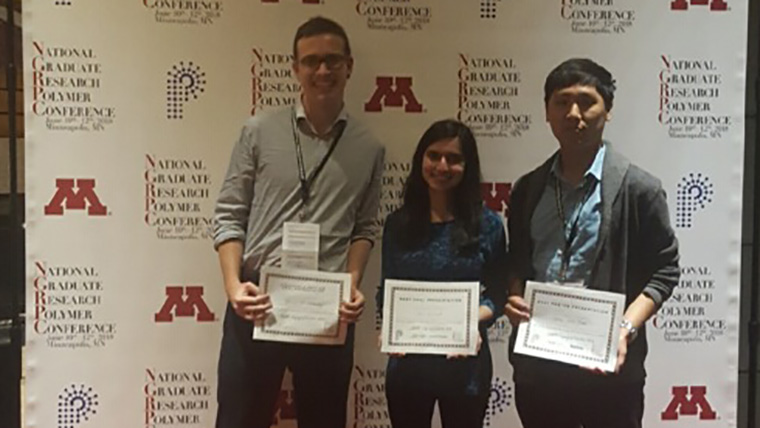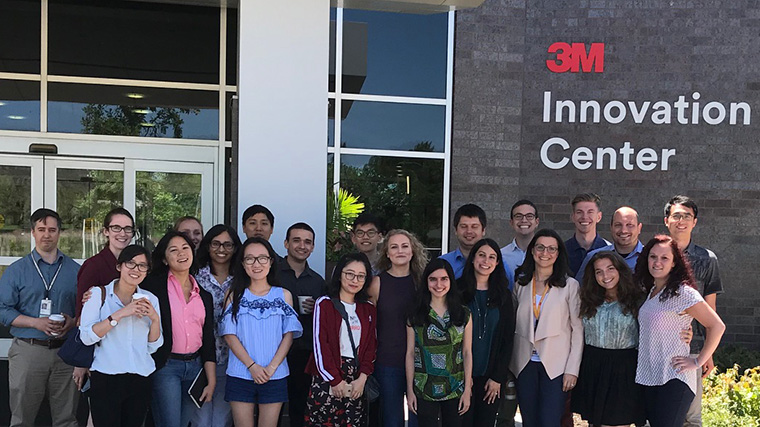The 2018 National Graduate Research Polymer Conference (NGRPC18) recognized three Georgia Tech Ph.D. students for outstanding presentations.
- Aditi Khirbat – top oral presentation
- Brian Schmatz – runner-up oral presentation
- Young Jun Yoon – top poster presentation
Held in the Twin Cities campus of the University of Minnesota on June 10-12, the conference aims to facilitate interactions between graduate students, postdocs, faculty, and industry representatives.
Aditi Khirbat is a second-year Ph.D. student in the School of Materials Science and Engineering (MSE). She is a member of the research group of Natalie Stingelin. Organic functional materials are a major research area for Stingelin.
In the Stingelin lab, Khirbat studies polymer blends for organic electronics applications, including photovoltaics. Her work includes processing, characterizing, and developing structure-property relations.
Khirbat’s award-winning oral presentation at NGRPC18 described how various properties of polymer blends can be manipulated by controlled blending and processing. “I hope to obtain insights in the correlation of structure, optics, and device characteristics of these multicomponent systems,” Khirbat says. Ultimately, the goal is to improve the performance of devices made with polymer blends.
When he attended NGRPC18, Brian Schmatz was a fifth-year Ph.D. student in the School of Chemistry and Biochemistry and a member of the research group of John Reynolds. Reynolds’ research revolves around conducting and electroactive polymers.
In the Reynolds lab, Schmatz has prepared and characterized electroactive conjugated polymers. These materials may be used in various printed-electronics applications.
For his runner-up oral presentation at NGRPC18, Schmatz talked about his work on ways to print conjugated polymers from aqueous solutions. The goal is to enable scalable and environmentally benign processing of electronic materials. Using the new method, Schmatz printed a transistor device using only environmentally benign solvents.
On June 18, Schmatz successfully defended his Ph.D. dissertation, “Processing Components in π-Conjugated Polymers: Controlling Solubility, Morphology, and Functionality through Structural Design.”
Young Jun Yoon is a fifth-year Ph.D. student in MSE. He works with Zhiqun Lin, whose research focus is nanostructured functional materials.
Under Lin’s direction, Yoon synthesizes and characterizes organic-inorganic hybrid materials for optoelectronics. Applications of these materials includes LEDs, lasers, and photodetectors. At NGRPC18, Yoon’s award-winning poster presentation described his work on a new way to prepare perovskite quantum dots.
The method uses star-like block copolymers as nanoreactors. “Our polymer nanoreactors enable precise control over optical properties,” Yoon says. The method drastically improves the stability of perovskite nanocrystals, he adds.
Khirbat, Schmatz, and Yoon were among 20 or so members of the Student Polymer Network at Georgia Tech (SPN@GT) who attended NGRPC18. They joined more than 250 attendees from 58 universities and nine companies with shared interest and passion for polymer science and engineering.
SPN@GT is part of the Georgia Tech Polymer Network, which Reynolds directs.
For More Information Contact
A. Maureen Rouhi, Ph.D.
Director of Communications
College of Sciences








